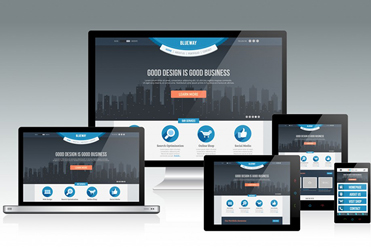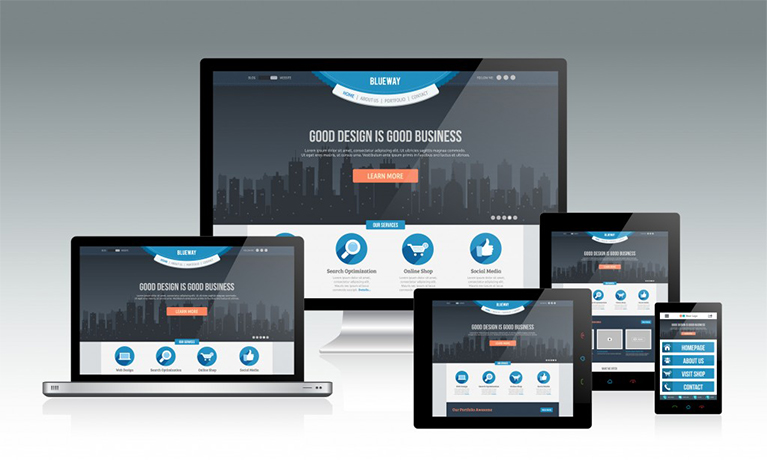

The aesthetic of a company’s website can give many indicators of company attitude, professionalism, and performance to potential customers. As a strand of marketing the business, proper, modern website design is an integral tool to employ. Some of the trends below may be the ticket to looking more modern, but what other perceptions will they inspire in your customers? Trendiness may be enough to improve your bounce rate, but it is isn’t necessarily enough to convert leads or charter respect.
Major web design trends and what they say about your business
Tiling and Geometry
Have you noticed the way apps are organized on virtually every mobile phone and device? This grid design was born from a necessity for organization – people needed to be able to find their calendar and calculator in 1999. Nowadays, this grid style has been reimagined into something modern and clean, but still functional. Many websites are taking their design cues from a user perspective by considering UX or UI, user experience or user interface. Now, à la Windows 8, a tiled style is welcome. People like to keep things in boxes and modern design says that’s okay. Even noninteractive geometric designs can lend to function as they draw the eye to various places and provide the outline for boxy buttons or a gridded gallery.
Keep your website practical and employ this trend if you are stockpiling a ton of information and want to keep it neat, or if your e-commerce site could use a product page revamp. Your company will be perceived as customer-focused, organized, modern, and even honest. When information is readily available and easy to access, customers feel less like they are being duped or roped in.
Minimalist Navigation
Perhaps you have seen it; the website where hovering over one primary navigation tab will invite a 14-item drop down menu that covers the entire page. The worst part? When you scroll to see item 14 (obviously the page you need), you deactivate the hover and the drop down is lost. Don’t be that company!
If this is starting to read more like an assessment of front end function, rest assured – this design element is more than just about content perusal. Websites that have information traveling in every direction look sloppy, and a massive drop down can be perceived as long-winded. Customers may feel that you are trying to distract them from a lack of quality by feeding them line after line, or they may feel overwhelmed and bounce to a new site with less garble.
Media Richness
It is a common piece of advice that is given freely; if you infuse your website with photos and videos, customers will come and they will stay. Though we know now that slapdash, low-res photos, and failed video embeds bring an inverse result to traffic and bounce ratings; is there a right or wrong way to richen the media?
Absolutely! Photos and videos should be a part of the design. Galleries, sliders, embedded videos and animation should not merely be awkwardly present amid the fabulous design of your website; they should give it an extra oomph! Many company websites use full-page sliders on the home page and tie the chosen images into the general feel of the page with arrows in the slider image that call customer’s attention to buttons outside the slider.
Another approach is to adopt a hero image, or image that becomes the background of the entire landing page and motivates navigation that is built over the top of the image. We advise against videos that autoplay, but videos should be inspired by the rest of the surrounding design and enhance the experience for the customer. The perception of this design is modern, artistic, and attentive to detail.
Flat Design
Flat design is conquering the World Wide Web by giving a modern feel to a very retro, 2D element of design. Icons, buttons, backgrounds and even typography are made modern without the shading and shadowing that once produced blocky, bubbly, or otherwise uninviting images. Now, these elements have a crisp finish, looking like letters on paper. If your company is pursuing a clean image or trend aware attitude, reject the photo-real or claymation appearance and choose a flat design.
Scrolling
The way your website moves is a good indicator of how it will move customer traffic. Different scrolling types say different things to customers:
Traditional. This scroll type, seen virtually everywhere, allows the user to scroll to the bottom of a page, the height of which is set by your design. Choose this to be seen as traditional. Customers perceive this common scroll type as not perceiving it at all, which is fine if your site calls attention in other ways. Only true design geeks will notice the standardization of this scroll, but the average customer will just consider your site as the norm.
Horizontal. Do you have what it takes to change the game? Do you believe that “if they give you lined paper, write the other way?” If your company is innovative, trend setting, and unafraid of risk, try a horizontal scroll. Everything on the site will move left to right instead of up and down, more like a slideshow than a traditional scrolling site. Customers will perceive this boldness immediately, but the movement may intimidate traditionalists.
Parallax. When you scroll on a parallax site, you are not scrolling down one page; you are actually scrolling to a new page with every wheel of the mouse. Parallax is great if you want to design a different motif for every page or really highlight new information. Parallax sites can sometimes feel like a stack of micro sites. Customers perceive a bold parallax scroll as cutting-edge, loud, fierce, and unique. If this is your company’s credo, go with parallax.
Fixed. Friendly with the traditional scroll, this one operates the same way but keeps the navigation stuck to the top of your screen no matter how far you scroll. The benefit? If a customer is ¾ of the way down the page and decides they want to look at shoes instead of sweaters, or air conditioners instead of water heaters, they don’t have to scroll, scroll, scroll back to the top. If customers notice this, which is really more of a convenience than a style item, they will appreciate it – guaranteed. In that case, your company will be perceived as intuitive, helpful, and still traditional.
Adding new media and refreshing content is not enough
Face it, this is a visual world and customers may not even see your hilarious product tutorial video or expertly written content if your site is unappealing. For more advisement on the topic of web design and customer perception, work with a professional in the field of digital marketing.
The post Modernizing Your Website: The How and Why first appeared on Web Design & Digital Marketing Tips.
